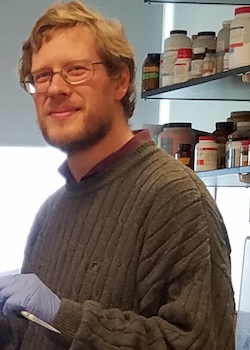
EMU Research
Center Stage 12-21-16: Personal Accounts of Awards & Research- Steven Backues- Scaffold or Assembly Line: How Does Atg11 Organize its Binding Partners for the Initiation of Selective Autophagy?

Hi, I’m Steven Backues, and I’m the principal investigator on a $297.384 grant from the National Science Foundation (NSF) for my Research in Undergraduate Institutions (RUI) project “Scaffold or Assembly Line: How Does Atg11 Organize its Binding Partners for the Initiation of Selective Autophagy?” This grant has two purposes. First, to enhance undergraduate education in the EMU Chemistry Department, and secondly, to advance our fundamental understanding of selective autophagy, a subcellular process important for the health of many organisms, including humans. Selective autophagy is important for maintaining cellular health and preventing many diseases. Therefore, in addition to enhancing our general knowledge of how cells work, studying the basic mechanisms of this process is a prerequisite for the eventual design of drugs that can modify or enhance selective autophagy for the benefit of human health.
The first molecular insights into how autophagy works came from the identification of the proteins that are necessary for autophagy. These were identified by yeast genetic screens carried out beginning in the mid 1990’s by a handful of research groups. (The 2016 Nobel Prize in Physiology or Medicine was just awarded to one of those researchers, Dr. Yoshinori Ohsumi, highlighting the importance of this work). One group that identified many proteins involved in selective autophagy was Dr. Daniel Klionsky’s group at the University of Michigan. Further research by other groups has shown that most of these proteins identified in yeast are also necessary for autophagy in other organisms, including humans. Now that most of the basic building blocks of autophagy have been discovered, attention has turned to studying these proteins and how they interact in order to understand how the process actually occurs at a molecular level.
I was a postdoctoral fellow in the lab of Dr. Klionsky prior to coming to EMU. There I worked on the transport of certain key autophagy proteins within the cell. During this time I became interested in a particular protein that was related to the ones I was working on, Atg11. This protein appeared to be a central organizer of many autophagy proteins, helping to form an “Autophagy Initiation Complex” during selective autophagy. However, Atg11 was very understudied, with little understanding of how it organized its partners spatially and temporally, so I decided to make it the focus of my current research.
This research is focused on better understanding selective autophagy, which is a cellular clean-up and recycling process used by animals, plants and fungi to maintain cellular health. Selective autophagy targets damaged or unwanted cellular components, such as toxic protein aggregates or malfunctioning mitochondria, and delivers them to the vacuole/lysosome where they are destroyed and their constituents recycled. Defects in selective autophagy in humans leads to neurodegenerative diseases such as Parkinson’s disease, as well as some cancers.
This research will explain how Atg11 organizes this complex by determining the characteristics of Atg11’s interactions with its protein partners. Specifically, it will determine whether Atg11 can bring together all of its partners at once, in the manner of a scaffold, or whether it interacts with them one at a time, in the manner of an assembly line. This information will help us to understand how selective autophagy actually occurs, not only in yeast but also many other organisms that share a similar machinery, including humans.
This research is all being carried out by chemistry undergraduates and Master’s students here at EMU under my mentorship and together generated the preliminary data that established the feasibility of this approach and therefore made it possible to convince the NSF review panel to fund this grant. This primarily involved showing that it was possible to produce the relevant portion of the Atg11 protein in bacteria. EMU’s slogan is “Education First.” Therefore, the primary focus of this work and of this grant is on how it supports undergraduate education in the Chemistry department. Studies have shown that the best way for students to learn science is to be involved in actual scientific research. Therefore, while this research will make important contributions to the body human understanding (else it would not be genuine research), the primary focus is on the learning opportunities that it creates for students , in two ways:
First, this grant will help to support mentored independent study research. It provides the funds necessary to buy the reagents to allow students to carry out this research, provides travel support to help students go to national conferences to present their findings, provides some scholarship support so that students can focus on doing research instead of working outside jobs, and helps support my time so that I can be an effective research mentor.
Secondly, as part of the grant I am bringing my research into the upper level biochemistry laboratory (CHEM453) by transforming it into a “Course-based Undergraduate Research Experience” (CURE). In this course the students are given an actual research project to work on (the attempt to produce different portions of the Atg11 protein), while at the same time developing their own research ideas in the form of a hypothetical grant proposal. In adopting this format I am following the lead of my biochemistry colleagues in the department, but expanding on their approach and making it relevant to my areas of interest and expertise.


